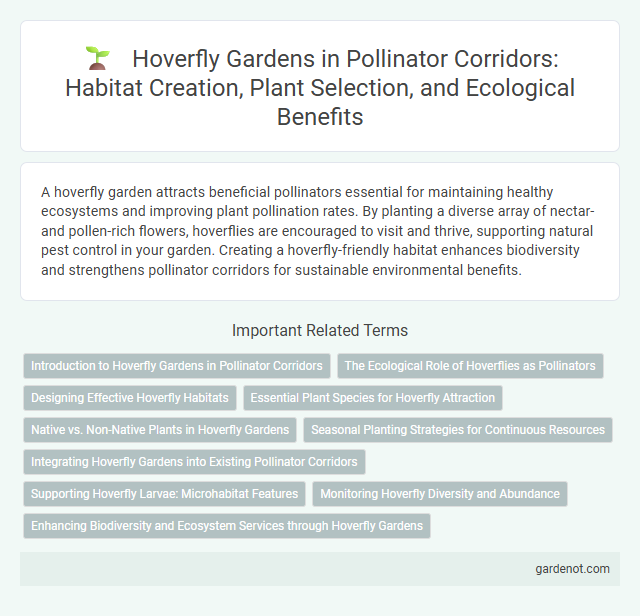A hoverfly garden attracts beneficial pollinators essential for maintaining healthy ecosystems and improving plant pollination rates. By planting a diverse array of nectar- and pollen-rich flowers, hoverflies are encouraged to visit and thrive, supporting natural pest control in your garden. Creating a hoverfly-friendly habitat enhances biodiversity and strengthens pollinator corridors for sustainable environmental benefits.
Introduction to Hoverfly Gardens in Pollinator Corridors
Hoverfly gardens play a vital role in pollinator corridors by providing essential habitats that support hoverfly populations, key pollinators for many flowering plants and crops. These gardens feature diverse flowering plant species that bloom throughout the growing season, offering nectar and pollen resources crucial for sustaining hoverflies. Integrating hoverfly gardens into pollinator corridors enhances biodiversity, promotes pollination efficiency, and helps maintain ecosystem health.
The Ecological Role of Hoverflies as Pollinators
Hoverfly gardens provide essential habitats that support the diverse ecological role of hoverflies as pollinators, facilitating the transfer of pollen among a variety of flowering plants. Hoverflies contribute significantly to ecosystems by enhancing pollination efficiency, particularly for crops and wildflowers, thus maintaining biodiversity and agricultural productivity. Their ability to thrive in diverse environments makes hoverfly populations vital for sustaining pollinator corridors and promoting ecosystem resilience.
Designing Effective Hoverfly Habitats
Designing effective hoverfly habitats requires planting a diverse array of nectar-rich flowers such as umbellifers and wildflowers that bloom throughout the growing season to provide continuous food sources. Incorporating shelter elements like grass tussocks, hedgerows, and undisturbed soil patches supports hoverfly larvae development and protection from predators. Ensuring proximity to water sources and minimizing pesticide use further enhances hoverfly survival and pollination efficiency within a pollinator corridor.
Essential Plant Species for Hoverfly Attraction
Planting essential species such as fennel (Foeniculum vulgare), marigold (Tagetes spp.), and wild carrot (Daucus carota) enhances hoverfly attraction by providing ample nectar and pollen sources. These plants support the larval stages by hosting aphids, a primary food source for hoverfly larvae, promoting population growth. Strategically incorporating diverse flowering plants with staggered bloom periods ensures continuous resources, optimizing the effectiveness of pollinator corridors.
Native vs. Non-Native Plants in Hoverfly Gardens
Hoverfly gardens thrive with native plants, which provide essential nectar and pollen sources specific to local hoverfly species, enhancing their pollination efficiency. Non-native plants may offer some food resources but often lack the specialized traits hoverflies need, potentially disrupting local ecosystems. Prioritizing native flora supports hoverfly biodiversity and sustains healthy pollinator corridors.
Seasonal Planting Strategies for Continuous Resources
Hoverfly gardens benefit from seasonal planting strategies that ensure a continuous supply of nectar and pollen throughout the year, supporting diverse hoverfly species. Early spring blooms like crocus and snowdrops provide crucial food sources as hoverflies emerge from hibernation, while summer plants such as lavender, fennel, and wild carrot sustain adult hoverflies during peak activity. Late-season flowering plants, including ivy and goldenrod, extend resources into autumn, promoting hoverfly survival and pollination services year-round.
Integrating Hoverfly Gardens into Existing Pollinator Corridors
Integrating hoverfly gardens into existing pollinator corridors enhances biodiversity by providing vital nectar sources and breeding habitats for hoverflies, key pollinators in agricultural ecosystems. Strategically planting native flowering species such as wild carrot, dill, and fennel within these corridors supports hoverfly larvae that control aphid populations, promoting natural pest regulation. This targeted habitat enrichment strengthens pollinator networks, boosting ecosystem resilience and crop productivity across connected landscapes.
Supporting Hoverfly Larvae: Microhabitat Features
Hoverfly larvae thrive in microhabitats rich in decaying organic matter, which provides essential nutrients and protection from predators. Incorporating elements such as compost heaps, damp leaf litter, and flowering plants creates an ideal environment for larval development. These features enhance the effectiveness of a pollinator corridor by sustaining hoverfly populations critical for pollination and pest control.
Monitoring Hoverfly Diversity and Abundance
Monitoring hoverfly diversity and abundance in a hoverfly garden involves systematic sampling using pan traps and sweep nets to capture various species across different seasons, providing data on population dynamics and habitat preferences. DNA barcoding and photographic records enhance species identification accuracy, supporting biodiversity assessments and conservation strategies. Continuous monitoring informs the effectiveness of pollinator corridors by tracking hoverfly populations as key pollinators within urban and agricultural landscapes.
Enhancing Biodiversity and Ecosystem Services through Hoverfly Gardens
Hoverfly gardens significantly enhance biodiversity by providing essential habitats and nectar sources for diverse hoverfly species, key pollinators in many ecosystems. These gardens support natural pest control as hoverfly larvae prey on aphids and other agricultural pests, reducing the need for chemical pesticides. Integrating hoverfly-friendly plants in pollinator corridors improves ecosystem services such as pollination efficiency and soil health, promoting sustainable agricultural landscapes.
Hoverfly garden Infographic

 gardenot.com
gardenot.com